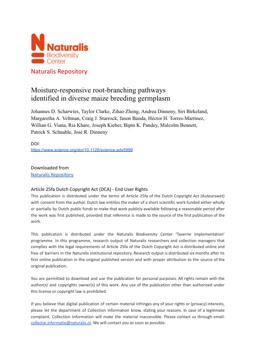2025-02-07
Moisture-responsive root-branching pathways identified in diverse maize breeding germplasm
Publication
Publication
Science , Volume 387 - Issue 6734 p. 666- 673
Plants grow complex root systems to extract unevenly distributed resources from soils. Spatial differences in soil moisture are perceived by root tips, leading to the patterning of new root branches toward available water in a process called hydropatterning. Little is known about hydropatterning behavior and its genetic basis in crop plants. Here, we developed an assay to measure hydropatterning in maize and revealed substantial differences between tropical/subtropical and temperate maize breeding germplasm that likely resulted from divergent selection. Genetic analysis of hydropatterning confirmed the regulatory role of auxin and revealed that the gaseous hormone ethylene locally inhibits root branching from air-exposed tissues. Our results demonstrate how distinct signaling pathways translate spatial patterns of water availability to developmental programs that determine root architecture.
| Additional Metadata | |
|---|---|
| doi.org/10.1126/science.ads5999 | |
| Science | |
| Released under the CC-BY 4.0 ("Attribution 4.0 International") License | |
| Organisation | Staff publications |
|
Scharwies, Johannes D., Clarke, Taylor, Zheng, Zihao, Dinneny, Andrea, Birkeland, Siri, Veltman, M., … Dinneny, José R. (2025). Moisture-responsive root-branching pathways identified in diverse maize breeding germplasm. Science, 387(6734), 666–673. doi:10.1126/science.ads5999 |
|
